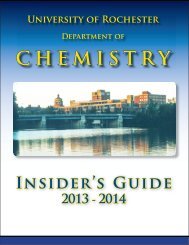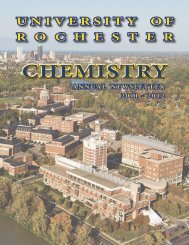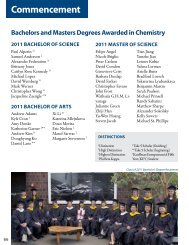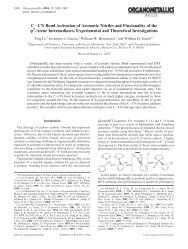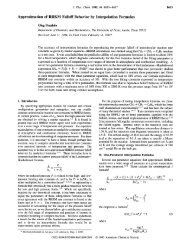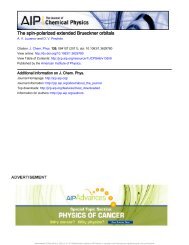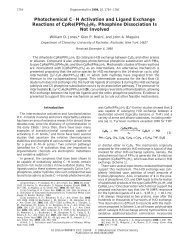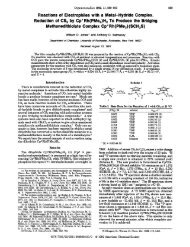ch 41.2.2-kadosh - Chemistry
ch 41.2.2-kadosh - Chemistry
ch 41.2.2-kadosh - Chemistry
You also want an ePaper? Increase the reach of your titles
YUMPU automatically turns print PDFs into web optimized ePapers that Google loves.
10<br />
simulation of ref 34. The NA transfer becomes significantly<br />
faster with a higher initial energy due to access to<br />
a larger density of TiO 2 states. However its contribution<br />
to the total ET is diminished, and the adiabatic me<strong>ch</strong>anism<br />
completely predominates over the NA me<strong>ch</strong>anism<br />
at high initial energies. The adiabatic and NA contributions<br />
are comparable at low energies. Pre-ET by<br />
photoexcitation is more important at higher energies<br />
and is less pronounced at lower energies, where the<br />
excited state dynamics plays a major role. Assuming<br />
that photoexcitation places the system in an adiabatic<br />
excited state, about 50% of ET occurs due to photoexcitation<br />
and 50% by excited state dynamics (Fig. 7c).<br />
4. DISCUSSION AND CONCLUSIONS<br />
The simulated photoinduced ET between the molecular<br />
electron donor and the TiO 2 acceptor typical of the dyesensitized<br />
semiconductor nanomaterials used in solar<br />
cells, photocatalysis, and photoelectrolysis applications<br />
is thermally driven at 350 K. Pronounced thermal effects<br />
are evident both in the equilibrium ground state<br />
fluctuations that define the distribution of initial conditions<br />
for ET, and in the nonequilibrium excited state ET<br />
dynamics that are dominated by the thermally activated<br />
adiabatic me<strong>ch</strong>anism. The rate of NA transfer is nearly<br />
un<strong>ch</strong>anged from 50 to 350 K, while the adiabatic ET rate<br />
is dramatically increased.<br />
A detailed picture of the ET process follows from the<br />
simulation. As should be expected, higher temperatures<br />
increase the likelihood of a fluctuation that can drive the<br />
ET coordinate over the transition state. The adiabatic ET<br />
is thereby enhanced at high temperatures, becoming<br />
mu<strong>ch</strong> more effective than the NA, predominating both<br />
in magnitude and timescale.<br />
Another, more subtle, effect is also induced by the<br />
thermal fluctuations. Since the photoexcited state is a<br />
π*-state localized on <strong>ch</strong>romophore carbons, thermal<br />
motions of the carbon atoms <strong>ch</strong>ange the energy of the<br />
state. Although the energy variation is only a fraction of<br />
an electronvolt, whi<strong>ch</strong> is small relative to the photoexcitation<br />
scale of several electronvolts, it has a significant<br />
impact on the ET process. Since the density of the<br />
semiconductor states increases with energy, the higher<br />
the energy of the electron donor, the more likely it will<br />
interact with an acceptor state. The oscillation of the<br />
photoexcited state energy slows down at the high and<br />
low energy turning points, and the energies tend to<br />
cluster around these points, resulting in a bimodal distribution<br />
of the initial conditions.<br />
The two distinct types of initial conditions observed<br />
in the simulation are responsible for two kinds of ET<br />
events. At lower initial energies the photoexcited state is<br />
localized primarily on the <strong>ch</strong>romophore, and the ET is<br />
Israel Journal of <strong>Chemistry</strong> 42 2002<br />
largely determined by the excited state dynamics. At<br />
higher initial energies a significant fraction of the ET<br />
has already occurred upon photoexcitation. The photoexcited<br />
state is significantly delocalized onto the semiconductor,<br />
and the excited state dynamics are responsible<br />
for only the last third of the ET. These conclusions<br />
are based on the adiabatic photoexcitation model, where<br />
it is assumed that the laser prepares the combined <strong>ch</strong>romophore–semiconductor<br />
system in an adiabatic excited<br />
state. A diabatic photoexcitation model provides the<br />
opposite limit, where the initial photoexcitation is assumed<br />
fully localized on the <strong>ch</strong>romophore, spanning 2<br />
or 3 adiabatic states. A more detailed analysis of the<br />
interaction between the system and the laser field is<br />
required in a general case.<br />
The ET in question has been proposed to be either an<br />
adiabatic ET in whi<strong>ch</strong> the donor state is strongly coupled<br />
to a single acceptor state, or a NA process in whi<strong>ch</strong> the<br />
donor state is weakly coupled to a manifold of acceptor<br />
states (Fig. 1). One may postulate that the reaction coordinate<br />
is an activationless NA direct transition from the dye<br />
state to a continuum of conduction band states. In this<br />
case, the Fermi golden rule would give an estimate of the<br />
reaction rate. If, however, the ET was an adiabatic transfer<br />
between the dye state to a particular conduction band state,<br />
a Marcus theory of ET would be more appropriate (eq 1).<br />
Relatively few (1–3) states of the conduction band initially<br />
couple to the excited state of the <strong>ch</strong>romophore. Often,<br />
especially with the low energy part of distribution of the<br />
<strong>ch</strong>romophore state energies, the acceptor states are higher<br />
in energy than the donor state, su<strong>ch</strong> that an activation is<br />
needed. Both activated ET and activationless direct relaxation<br />
are observed in this study.<br />
The timescales and dominant me<strong>ch</strong>anisms of ET<br />
vary, depending on whether the initial state has high or<br />
low energy. At high initial energies ET is extremely fast<br />
and purely adiabatic. At low initial energies barriers to<br />
ET arise, and the contribution of the NA me<strong>ch</strong>anism<br />
approa<strong>ch</strong>es that of the adiabatic me<strong>ch</strong>anism. The timescale<br />
of ET by the NA me<strong>ch</strong>anism mat<strong>ch</strong>es the NA ET<br />
timescale of the low temperature simulation. 34 The large<br />
differences seen in the features of the ET processes<br />
occurring at low (50 K, ref 34) and high (350 K, this<br />
paper) temperatures suggest that a systematic study of<br />
the ET process over the whole temperature range can<br />
produce a Marcus theory description of ET, eq 1, with<br />
adiabatic activation energy, NA transmission factor κ,<br />
and turnover between a quantum NA tunneling regime<br />
and a thermally activated adiabatic ET regime.<br />
For the system under study, ET occurs on a 5-fs<br />
timescale. This is in agreement with the ultrafast experimental<br />
data for the alizarin 18 and bi-isonicotinic acid 25<br />
<strong>ch</strong>romophores that, similarly to our model, are directly




